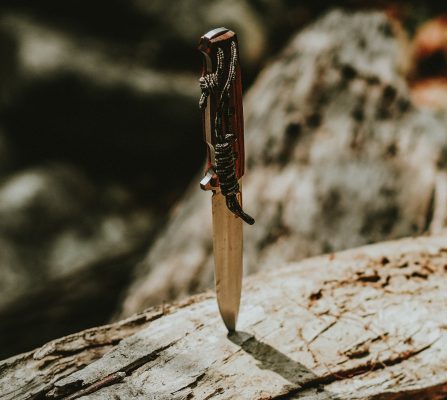
A survival knife is one of the most essential survival tools that you’ll need if you’re bugging out in the wilderness or camping outdoors. A normal kitchen knife is just not going to cut it (pun fully intended).
A good survival knife has several qualities that go beyond cutting meat and vegetables. In the wilderness, you may need to cut several things and the knife may be used for several purposes from starting fires to cutting ropes. It’ll depend on the situation.
Choosing the right survival knife is crucial, and in this article we’re going to explore the different features that tactical knives have and what they mean to you. This is a very deep topic on its own. It’s best to speak to the salesperson at the store so that you can get more information about the knife before buying it.
Types of Knives
Most knives fall under 3 categories: large fixed blade, small fixed blade, and foldable knives. Of course, the strongest knives are the ones with the large fixed blade. They’re easier to handle because they’re heavier and you can use them to clear foliage and do other more heavy-duty tasks.
The one drawback to such knives is that they’re best used outdoors. In most places, it’s not legal to use these knives for self-defense and even openly carrying them on your belt will draw stares.
The smaller fixed blade knives will be useful for chopping sticks or scraping flint to start a fire. They’re also useful for gutting, cleaning and skinning meat and fish. The large knives are too large and the foldable ones are not very safe to use because they might fold over and cut your finger.
Foldable knives are knives such as Swiss army knives, karambits, etc. The small knifes are best use for more intricate work. If you need to cut paracord or tighten one of the screws in your spectacles, smaller knives are very useful.
The karambit is a small curved blade and it’s exclusively used for self-defense. While not effective for stabbing, it’s used for slashing. This is a very deadly knife and despite it being foldable, it locks upon opening so that the blade doesn’t fold back and injure you.
You should have one of each type of knife depending on where you’re going and what you’re planning to do.
What to Look Out For
The steel used in the knives matter a lot. High-carbon steel and hardened stainless steel are ideal. You need to be aware that different knives have different purposes. Double-edged knives like tactical daggers are best used for self-defense while the big fixed blade single-edged knives are great for cutting meat, cutting wood, etc.
What’s a drop point? If you notice that the top part of the blade has a slight curve from the spine to the blade, it’s a drop point survival knife. These knives are easier to handle and control.
A clip point, however, has a straight blade that has a slight curve midway and drops the tip of the blade lower than the spine. This creates a very strong knife tip.
You should also know the different types of grinds. There are saber grinds, full flat grinds with bevel, convex grind and so on. There’s just too much detail to go into it here.
Just know that each feature has a purpose and you can do your research online and speak to a salesperson or an expert to learn more. Get a couple of survival knives that will serve you well when you’re outdoors and learn to handle them safely. Knives can cause sudden injuries if you’re distracted for even a second while using them. So respect them and give them your full attention and they’ll serve you well.

